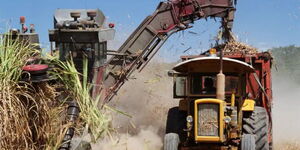Police have been deployed to Nduma village in Kikuyu, Kiambu County, after a farmer discovered a highly explosive mortar bomb while ploughing his land, sparking tension among residents.
The residents of Nduma were thrown into a state of panic when the farmer came across the 80 mm artillery bomb, commonly known as an '80 mic mic', which is believed to date back to the colonial era.
Kikuyu Sub-County Police Commander Joseph Ndege confirmed the incident and said that officers from the Bomb Disposal Unit had been sent to deal with the bomb.
Speaking to the press on Friday October 24, Ndege said that the area had been cordoned off to allow the bomb squad to deal with the explosive device.
Ndege further added that the bomb specialists had decided against detonating the bomb in the farm, citing the potential harm to the land and its surrounding areas.
“The bomb is likely to cause damage, and the threshold to which it can explode is a distance of more than 50 meters,” he said.
“As a result, it has been determined that this bomb be exploded somewhere safer, preferably in Kanyoyo, but we shall leave it to the experts,” Ndege added.
The bomb that was discovered is a smoothbore, muzzle-loaded mortar that fires fin-stabilised bombs. Mortars typically fire high-angle indirect shots over short to medium ranges.
Coming from the British 3-inch/81 mm family such as the Stokes and Ordnance ML 3-inch, mortar bombs were invented in World War I and saw use throughout the British Empire
The Ordnance ML 3-inch mortar and Brandt-pattern 81 mm mortars remained standard into WWII and after, and were common in imperial forces and colonial policing or military operations.
In colonial contexts such as the British campaign in Kenya and the time of the Mau Mau insurgency and other uprisings, British forces used a mix of small arms, mortars, field guns and air assets.
Notably, old mortar bombs can remain live for decades, with bomb specialists always advising against touching old shells.
In the same breadth, Ndege urged Kenyans to be extra cautious when handling suspicious gadgets, advising them to call the police in such scenarios.












